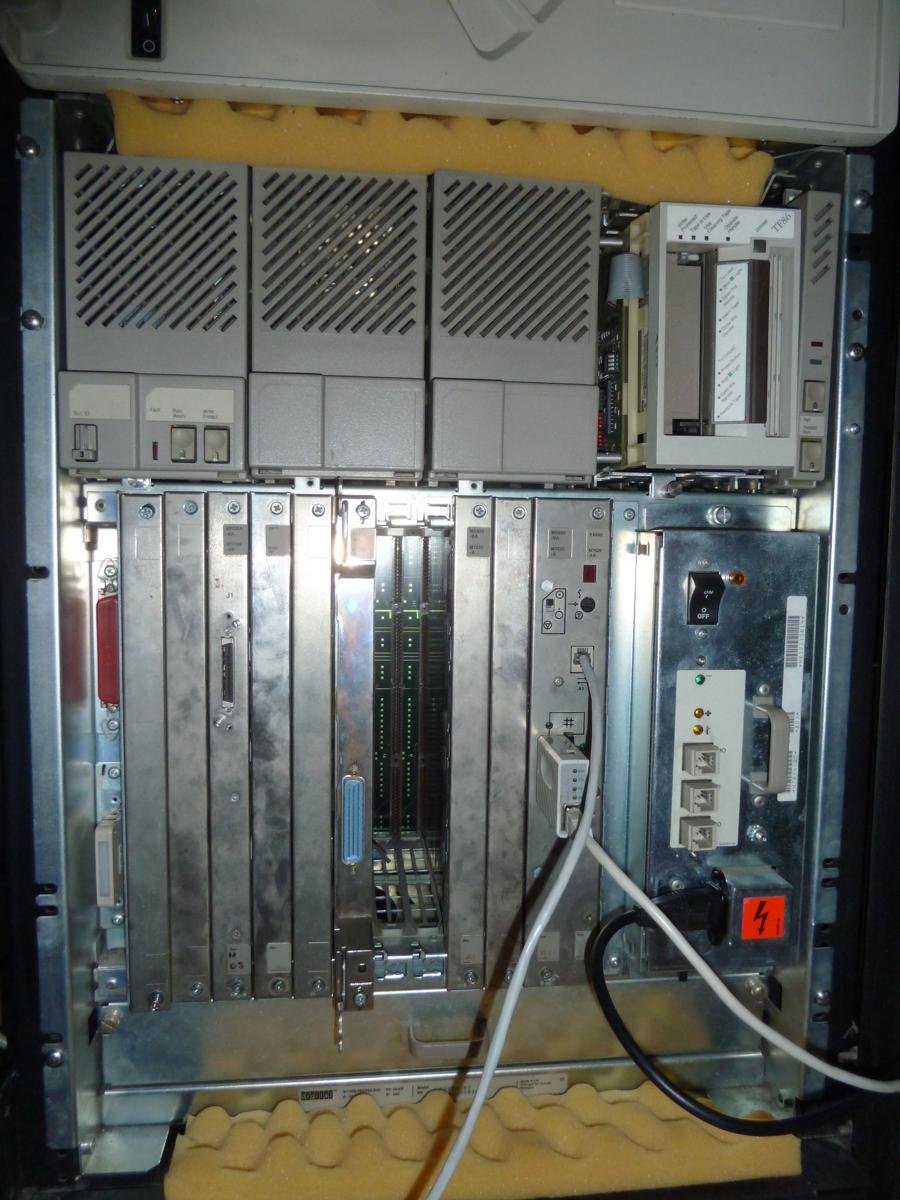Story:
The VAX 4000-200 (DEC-internal codename
"Spitfire") was the last VAX system completely
built around the DEC's popular bus called "Q-bus". The
processor board named KA660 was the fasted one for Q-bus
based systems and was heavily used for upgrades of older
microVAXen and VAXservers (Models 3300/3400/3800/3900 and
MicroVAX-II/III/III+).
The so-called VAX SOC chip is a
"System-on-Chip" version of the CVAX-processor which was, in addition to above
named field upgrades, used in the VAXstation 4000
VLC, the MicroVAX 3100 Models M30 and M40 and the
VAX/VAXserver 4000-200. The CPU uses 6kB of L2-cache, runs
with a cycle time of 35ns and also includes the floating
point unit (CFPA) of the CVAX-processor. It was produced
using DEC's "CMOS-3" process (1 micron, three metal layers).
The CPU-board is equipped with the
"Single Host Adapter to Interface DSSI" (SHAC) chip and a "Second Generation
Ethernet Controller" (SGEC) to decouple DSSI and
the network traffic from the Q-bus and to make full usage of
the DSSI-performance in terms of bandwidth which is higher
than the one offered by the Q-bus.
This particular system was my very first VAX-computer!.
It came to me via ebay in 2003, not knowing anything about its
history before being sold on ebay. It probably was used in a
networked or DSSI-clustered environement, as it neither
contained DSSI harddisks nor an internal tape drive. The drive
shelves were convered with filler panels. Besides 8 MB of
memory, one single additional KFQSA-card was mounted, which
might have been used for DSSI-Clustering or external DSSI
pheripherals.
The BA400-series chassis is in my point of view very well
designed. The plastics enclosure can be removed, so that the
chassis can be placed in a 19" cabinet. Just removing the
plastics enclosure turns it into a rack-mountable VAX :) In
contrast to the VAX 4000-300 using a BA440 backplane and
chassis, the 4000-200 uses the BA430 backplane and chassis.
They differ amongst others in terms of CPU/memory board
location and connector types. The Compared to the BA430
backplane, the BA440 backplane uses dedicated CPU and memory
boards slots to get higher performance compared to the qbus
used in BA430.
The BA430-backblane used for the VAX 4000-200, which is a
4-layer backplane (two signal layers, one power layer and one
ground layer), offers the possibility to connect a SCSI
controller (qbus-based or DSSI-to-SCSI bridge) to a
SCSI-device installed in the right-most device shelf of the
chassis via an external SCSI-cable attached to a dedicated
backplane connection. This offers the possibility to install
an RZ-type SCSI disk drive or a TZ-type SCSI tape drive into
the VAX rather than using a DSSI-device or a TK50/TK70 tape
drive.
This VAX was my opening gate to the VAX platform, learning
alot about it and getting into touch with its native operating
system OpenVMS and - as an alternative - the UNIX BSD-derative
called NetBSD.
Configuration:
Using an Emulex UC08 SCSI controller on the Q-bus, a Fujitsu
5,25" SCSI harddisk and a Cipher 995S reel tape drive (aka
TSZ07, DEC labeled) became accessible. The Fujitsu disk became
the NetBSD system disk. In parallel, OpenVMS was installed on
a RA92 disk using a KDA50 SDI Q-bus controller. I used this
configuration until 2005 and really had fun with that VAX!
Between 2005 and 2010, I moved several times during my studies
and did not have time to play with it.
In 2012, I digged it out again in order to use it primilarly
as a test system for peripherals such as harddisks and
external tape-drives.
After powering it up again after several years of
hibernation, it turned out the Fujitsu harddisk was bad.
Moreover, while working with it regularly again, I could
observe who the CPU-board slowly died. In the beginning it did
not always pass the power-up tests and with time, it became
worse and worse so that it never passed the tests in the end.
Thankfully, a kind computer fellow offered to me a working
board if I would give him my bad CPU-board. Since then, my VAX
works happily again!
Since 2012, openVMS 7.3 is installed on a 2GB large DSSI-disk
(RF73) and a KLESI-controller (DSSI) is installed, which
offers possibility to make use of a TU-81plus reel tape
drive.
